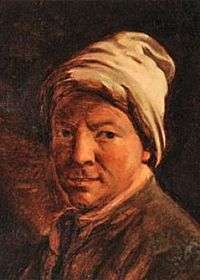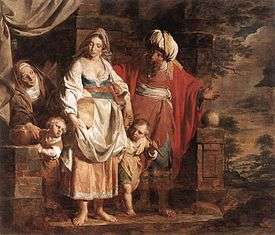Pieter-Jozef Verhaghen

Pieter-Jozef Verhaghen (19 March 1728, Aarschot - 3 April 1811, Leuven) was a Flemish painter in the style of Rubens.
Biography
His father was a surgeon. In 1741, he had a chance meeting with the itinerant painter Jan-Baptist van den Kerckhoven (ca. 1709 - 1772),[1] who was in Aarschot to restore a painting. Kerckhoven discovered his talents and convinced his parents to give him art lessons. He was enrolled at the Royal Academy of Fine Arts in Antwerp and also worked in the studios of Balthasar Beschey.[1]
In 1749, he was commissioned to decorate the home of a wealthy brewer in Leuven. While there, he met his future wife. They were married in 1753, settled in Leuven, and opened a small studio.[2]
By 1770, his reputation was such that he became court painter to Prince Charles Alexander of Lorraine, Governor of the Austrian Netherlands. The Prince presented one of Verhaghen's paintings as a gift to Empress Maria Theresa who, in turn, awarded him with a stipend to study the Old Masters in Italy.[2] He began his trip the following year, accompanied by his eldest son, making a stop in Paris, then spending two years in various locations. While there, it is said that Pope Clement XIV was so impressed with his work that he offered plenary indulgence to him, his family, and thirty friends of his choice.[1]
On his way back, he stopped off in Vienna, where he painted a portrait of Saint Teresa for the Queen, who appointed him a court painter, but he chose not to remain there and was granted permission to leave.[1] His homecoming in Leuven was celebrated with a parade and a banquet at City Hall.
Religious institutions were his most important customers, so his career suffered from the Austrian government's efforts to curb the influence of the Catholic Church. His only son died in 1804. Five years later, he had a stroke that left him unable to paint. His wife died in 1810, and he succumbed shortly after.[2]
He was a very prolific painter. His works may be seen in museums throughout Belgium and abroad and on display at Saint Quentin's Church in Leuven, Averbode Abbey and Park Abbey.[2] His older brother Jan-Jozef (1726-1795) was also a painter who worked in a lighter style reminiscent of David Teniers the Younger.[3]
References
- 1 2 3 4 Short biography from Bryan's Dictionary of Painters and Engravers, Vol.5
- 1 2 3 4 Brief biography @ Comité Leuven-'s-Hertogenbosch.
- ↑ Jan-Jozef Verhaghen @ the Virtueel Museum Aarschot.
Further reading
- Peter Carpreau, Veronique Vandekerchove: Pieter-Jozef Verhaghen, 1728-1811: in het spoor van Rubens, Stedelijk Museum, Peeters (2011) ISBN 90-429-2527-2
External links
| Wikimedia Commons has media related to Pieter Jozef Verhaghen. |
- ArtNet: More works by Verhaghen
- "200 jaar P.J. Verhaghen" @ Heemkunde, Vlaanderen.
- "Pieter-Jozef Verhaghen, in het spoor van Rubens" @ Historiek.
- "Il viaggio di Verhaghen a Napoli" by Paola Moreno, from Incontri (2012)

